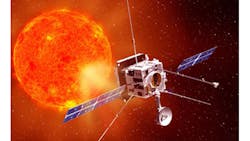Customized CMOS Imagers Will Provide Large-Format Close-ups of the Sun
The Solar Orbiter mission—a joint effort between NASA and the European Space Agency (ESA)—aims to track space weather events like coronal mass ejections (CMEs). Such events can affect electromagnetic (EM) fields on earth, disrupting power lines, satellite communications, and even cell-phone service. Monitoring of the occurrences is possible thanks to large-format complementary-metal-oxide-semiconductor (CMOS) imager engineering units. Those units are part of the Solar Orbiter Heliospheric Imager (Solo HI) optical telescope.
The CMOS detectors, which were recently delivered to the Naval Research Laboratory (NRL), are the largest ones to be used in the Solar Orbiter mission thus far. The imager comprises a CMOS image sensor (CIS), which was built using TowerJazz’s customized 0.18-μm CMOS technology. The imagers are radiation-hardened and 2k x 2k (4-megapixel). The full-flight Solo HI focal plane will incorporate a total of four imagers, providing a 4k-x-4k (16-megapixel) format.
The resulting large field of view will allow the Solo HI to take high-resolution images of the corona and solar wind—180-km-wide in detail—while connecting remote-sensing observations of the corona to the plasma being measured in situ at the spacecraft. Using the customized TowerJazz 0.18-μm process as the manufacturing platform, each imager offers a wide spectral range of deep-ultraviolet (UV) to near-infrared with high-speed capabilities and low noise.
The Solar Orbiter
The three-axis-stabilized spacecraft re-uses BepiColombo unit designs with 1100 W of power. Aside from the heliospheric imager, it is equipped with the following: a solar wind analyzer (to sample protons, electrons, and heavy ions in solar wind); an energetic particle detector (to measure timing and distribution functions of accelerated energetic particles); a magnetometer (to take measurements of the heliospheric magnetic field); and a radio and plasma wave analyzer (which studies local EM and electrostatic waves as well as solar radio bursts). Remote-sensing instruments include an extreme-ultraviolet imager (to study fine-scale processes and large-scale eruptions), a spectrometer/telescope for imaging X-rays (to study hot plasmas and accelerated electrons), and a multi-element telescope for imaging and spectroscopy (for high-resolution UV and extreme-UV coronagraphy).
At its nearest point, the Solar Orbiter will be closer to the sun than any previous spacecraft. It also will be the first satellite to provide close-up views of the sun’s polar regions, which are extremely difficult to see from earth. Expected to launch in 2017 with a mission time of three years, the satellite has been designed with a heat shield to withstand the intense heat and harsh environment.
Information used in this article was gathered from the “Solar Orbiter Science Presentation.”
About the Author
Iliza Sokol
Associate Content Producer
Iliza joined the Penton Media group in 2013 after graduating from the Fashion Institute of Technology with a BS in Advertising and Marketing Communications. Prior to joining the staff, she worked at NYLON Magazine and a ghostwriting firm based in New York.
